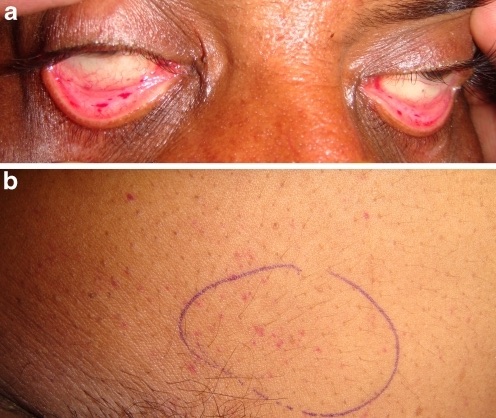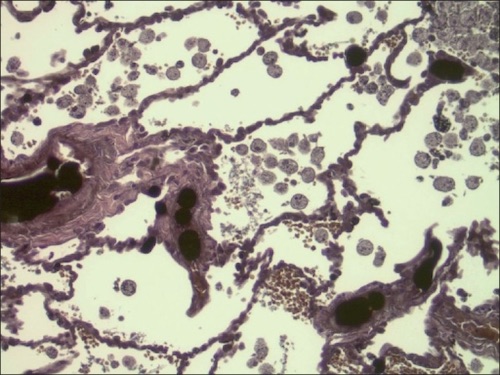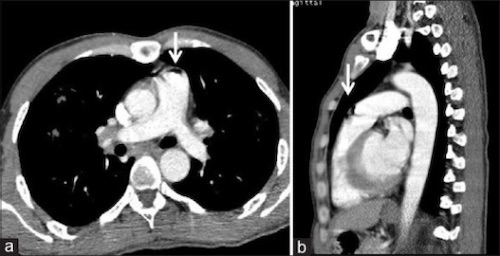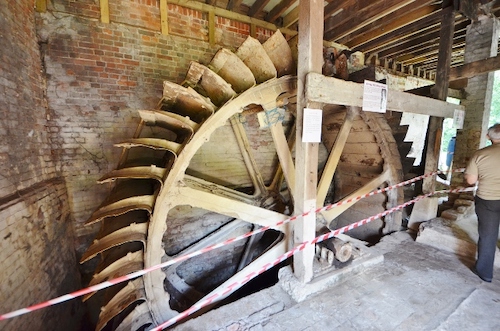Vascular: Other Venous Emboli
Fat Emboli
Definitions
- Fat Embolism – Fat Globules in the Pulmonary Circulation
- Fat Embolism Syndrome (FES) – Clinical Syndrome that Develops After a Fat Embolism
- From Fat Globule Release into Circulation
- Most Fully Resolve Spontaneously within a Few Days
Causes
- Orthopedic Fractures
- Long Bone (Femur) & Pelvic Fractures – Accounts for Almost All Cases
- High Content of Fat in Bone Marrow
- Typically Present 1-3 Days After Fractures
- Trauma
- Burns
- Pancreatitis
- CPR
Presentation
- Classic Symptomatic Triad:
- Hypoxemia – Generally the First Sign
- Neurologic Abnormalities – Generally Develops After Hypoxemia
- Petechial Rash – Generally the Last to Develop
- Pulmonary Signs:
- Hypoxemia – The Most Common Feature (> 90%)
- Dyspnea
- Tachypnea
- Often Develop a Syndrome Indistinguishable from ARDS
- Neurologic Signs:
- Altered Mental Status
- Seizures
- Focal Deficits
- Petechial Rash (20-50%) – From Fat Occlusion of Dermal Capillaries
- Less Common Manifestations:
- Anemia
- Fever
- DIC
- Hypotension
- Myocardial Depression
Diagnosis
- Primary Diagnosis: Clinical Diagnosis
- CTA Can Rule Out PE
- Supportive Findings (Low Sensitivity/Specificity – Rarely Performed):
- Bronchoscopy with Bronchioalveolar Lavage (BAL) – Detects Fat Droplets in Alveolar Macrophages
- Pulmonary Artery Catheter – Fat Detected in a Wedge Sample
- Urine/Sputum Samples – Detection of Fat
Treatment
- Primary Treatment: Supportive
- Early Fracture Immobilization/Repair Prevents FES – Unclear if it Helps Treat Established FES
- Therapeutic Anticoagulation Not Advised – Risk for Hemorrhage & Increased Free Fatty Acid Production

FES Petechial Rash 1

Lung Section with Extensive Fat Embolism and Fat Droplets in Alveolar Macrophages 2
Air Embolism
Causes
- Central Venous Catheter – Most Common Cause
- Surgery
- Vascular Interventions
- Trauma
- Mechanical Ventilation Barotrauma
Presentation
- Hypoxemia & Respiratory Distress
- Neurologic Abnormalities if Embolized to Arterial System
- “Millwheel” Murmur: Loud Churning
- Myocardial Infarction is Rare – Usually Due to Air Entrance into the Arterial System Through a Congenital Heart Defect
Diagnosis
- Diagnosis: Demonstration of Intravascular Air with Known Risk Factor
- Often Rapidly Absorbed Prior to Imaging
- Consider Echo or CT
Treatment
- Primary Treatment: Repositioning & Supportive Cares (Supplemental Oxygen)
- Repositioning:
- “Durant’s Maneuver” – Left Lateral Decubitus (Left Down)
- Trendelenburg – Head Down
- Goal: Positioning to Trap Air in the Right Ventricle
- First Step is Repositioning Even Before Diagnosis if There is Concern
- Options If Hemodynamically Unstable:
- Hyperbaric Oxygen
- Attempt Aspiration Through a Central Venous Catheter
- Chest Compressions to Force Air into Smaller Vessels

Air Embolism (Arrow) in Pulmonary Artery 3

Mill Wheel 1
References
- Sogunuru G, Moka N. Fat embolism syndrome. Int J Emerg Med. 2010 Apr 1;3(4):471. (License: CC BY-NC-2.0)
- Eriksson EA, Schultz SE, Cohle SD, Post KW. Cerebral fat embolism without intracardiac shunt: A novel presentation. J Emerg Trauma Shock. 2011 Apr;4(2):309-12. (License: CC BY-NC-SA-3.0)
- Sodhi KS, Saxena AK, Chandrashekhar G, Bhatia A, Singhi S, Agarwal R, Khandelwal N. Vascular air embolism after contrast administration on 64 row multiple detector computed tomography: A prospective analysis. Lung India. 2015 May-Jun;32(3):216-9. (License: CC BY-NC-SA-3.0)
- Dace A. Wikimedia Commons. (License: CC BY-SA-2.0)